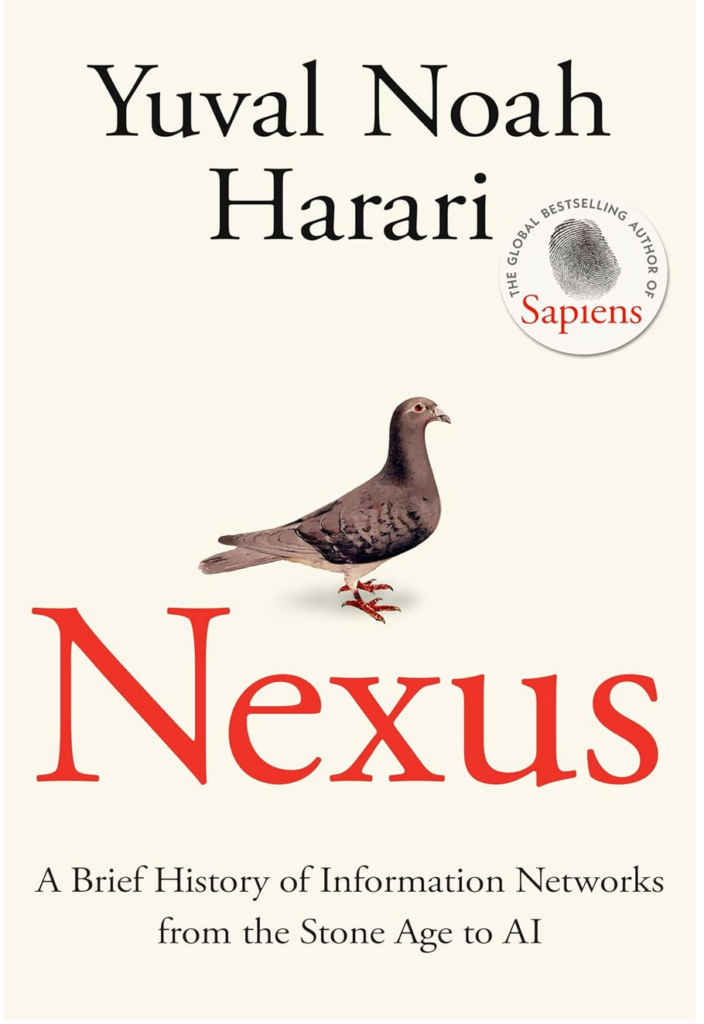
- Harari establishes at the outset that information networks are not neutral conduits of facts but powerful forces in shaping reality itself.
- The problem, he suggests, is not merely that false information circulates but that whole networks can be constructed around the maintenance of fictions.
- Harari depicts AI as a self-contained system likely to become an even larger source of fictions and fantasies than previous information networks.
- Despite its speculative tone, Nexus succeeds in revealing how the same dynamics that once governed religious texts and totalitarian propaganda now underpin social media and artificial intelligence.
Yuval Noah Harari has earned the status of one of the leading storytellers of big stories about humankind. In Sapiens and Homo Deus, he demonstrated an uncanny ability to streamline large swathes of history into persuasive arguments about who we are and where we might end up. Nexus: A Brief History of Information Networks From the Stone Age to AI, published in 2024, is yet another ambitious synthesis, where he exemplifies how the flow of information, and its governance, have steered human civilisation from one era to the next. The book follows mankind’s progress from the Stone Age through such seminal events as the codification of the Bible, witch hunts in Europe, Stalinism, Nazism, and right up to the artificial intelligence of today through the optics of information networks. The result is a volume both provocative and disconcerting, offering an account of our current plight and a cautionary tale about our technological destiny.
The Power of Shared Fictions
Harari starts Nexus with a return to one of his most compelling insights from the beginning: the unique ability of humankind to create and believe in shared fictions. The book explores the interrelations of information and truth, bureaucracy and mythology, and wisdom and power, establishing at the outset that information networks are not neutral conduits of facts but powerful forces in shaping reality itself. Money, nations, corporations, and religions exist in no physical sense at all, yet because we collectively act like they do, they become real enough to organise billions of people and transform the physical world. This ability to cooperate through shared myths, as Harari reminds us, is precisely the means whereby Homo sapiens came to dominate the planet.
Nevertheless, a significant conflict within the text is disclosed quite early on: in the case of individuals, humanity as a whole is asking for the truth about itself, its experiences, and its surroundings, while the gigantic information networks create a bond among their members and rule them through lies and dreams. Harari illustrates the same paradox in every chapter, saying that society has always been making the choice to pleasure themselves with the falsehoods that were the least painful rather than to face the harsh realities when those falsehoods added to the norms of the cohesion of the society or the power of politics. The central theme of the book is whether we will manage to free ourselves from this trend, especially in a scenario where we are moving into a new age where AI will probably be creating stories that we won’t be able to tell apart or supervise.
From Bureaucracy to Mythology
As Nexus progresses through history, Harari illustrates how information networks evolved both in complexity and in reach. Inventions like writing allowed bureaucracies to fashion empires spanning a continent, as tax records, legal codes, and administrative documents became the connective tissue of civilisation that permitted coordination on scales unimaginable before. These systems, Harari argues, often give priority to order over truth, providing rigid structures that resist correction even when demonstrably wrong.
The chapter on European witch hunts is particularly chilling, as it shows, based on complete fabrication, how an entire information network dedicated to identifying and punishing witches came into being. In this, Harari displays one of the key insights of the book: information networks can become self-reinforcing systems that generate their own reality. The apparatus of the witch hunt included legal procedures, expert testimony, standards for documentation, and a body of theoretical literature-all the trappings of a legitimate information system-but it was fundamentally disconnected from reality. The demise of the network took place because it was incapable of self-correcting and had no way of validating its basic premises.

This is a historical case that resonates with present-day worries regarding echo chambers and algorithmic amplification; however, Harari is cautious in making simplistic analogies. Instead, he uses these historical case studies to develop a more nuanced understanding of how information systems can go catastrophically wrong. The problem, he suggests, is not merely that false information circulates but that whole networks can be constructed around the maintenance of fictions, complete with sophisticated mechanisms to exclude contradictory evidence.
The Modern Dilemma
Harari reflects on the issue of the current existential crisis because of the reasons of power and knowledge having been the ruling humans’ main characteristics during the last 100,000 years; now, there is a coming to an end of the world, lies being told everywhere, and machines taking over. This question keeps the reader thinking in the second half of the book, where the main character isn’t just the modern world of information and the reality of artificial intelligence, but rather everybody’s conviction that he/she is the one able to decide what to believe. Thus, the change seems both natural and shocking. It is natural in the sense that AI is the logical end of the story of mankind’s inventing communicative and information technologies, but shocking too in that the extent and the seriousness of the threat seem to be of a different category than ever before.
Harari depicts AI as a self-contained system that has nothing to do with external reality and is likely to become an even larger source of fictions and fantasies than previous information networks. In contrast with bureaucracies or media systems, which, despite their flaw, nevertheless involve human judgment at many places, AI systems could theoretically work entirely without human agency, generating and acting upon information with little meaningful human oversight or control. This raises profound questions about control, accountability, and the very nature of truth in a world where machines might be better at persuasion than revelation.
Yet this portion of Nexus may prove less satisfying than its historical analysis for some critics. For all of his brilliance in excavating the past for insights into information networks, Harari’s forecasts regarding AI can occasionally strike the reader as more speculative than analytical. Although he is one of the few researchers who dare to warn about the dangers of AI, his arguments are not easily distinguishable from those of Nick Bostrom, Max Tegmark, and other scholars who argue that mankind is already playing with fire. At times, the book has the feel of standard AI safety discourse rather than being a distinctly Hararian contribution.
Between Naivety and Despair
Despite the generally dark trajectory of Nexus, in the conclusion to the book, Harari suggests that humans are quite capable of building balanced information networks that keep their own power in check, if we avoid both complacency and despair. This calls for an abandonment of what he calls both “naive” and “populist” views of information: the naive view that more information automatically means more truth, and the populist view that experts and institutions can be invariably corrupt. Information for Harari is neither a raw material of truth nor just a weapon; the book hopes to find an auspicious middle ground between these poles by way of rediscovering our common humanity.
This conclusion might seem less than fully earned to some readers, given the richness of the evidence that Harari assembles concerning humanity’s historical relationship with information. After hundreds of pages documenting how information networks have repeatedly chosen power over wisdom, fictions over facts, the suggestion that we might suddenly develop the collective discipline to constrain AI feels optimistic to the point of wishful thinking. One reviewer remarked that while Harari writes, “the fault isn’t with our nature but with our information networks,” one has to ask whether we can forgive human nature for so willingly falling prey to misleading information that blinds us to reality.
A Timely Warning
What makes Nexus valuable despite these reservations is Harari’s ability to synthesise diverse historical examples into a coherent framework for understanding our present moment. The New York Times called the book “ambitious, bold and at times, unsettling,” noting that “for anyone interested in the intersection of history, technology and power, Harari once again provokes deep thought”. The book truly succeeds in showing how phenomena that would not seem to relate in any way-the codification of religious texts, totalitarian propaganda systems, and social media algorithms, for instance-reveal themselves to be the manifestations of the same dynamics.
Harari’s prose remains accessible without being simplistic-a quality that has made his previous books bestsellers across demographics. He avoids not only the deadening vocabulary of academic discourse and the exaggerated sensationalism of popular tech writing but also a measured tone that recognises the contributions and setbacks of human information networks. His examples are carefully chosen to illustrate a point but not to be boring, while he respectfully acknowledges the complexity of the situation as he generalises from historical events.
The book is also to some extent an outcome of Harari’s truly global outlook: in contrast to the majority of Western writers on technology and society, he cites illustrations from Chinese history, Indian customs, and African experiences, without making the mistake of regarding European or American occurrences as the default human narrative. This vastness not only adds to his analysis but also to his arguments’ persuasive power since they are not limited by the specifics of any certain cultural tradition.
Final Thoughts
Nexus is not a perfect book. At times, its discussion of AI risks feels derivative; its hopeful conclusion is not altogether substantiated by the evidence it marshals. Readers looking for concrete policy recommendations or technical details about how proposed information network reforms might actually work will find themselves wishing for more. But these limitations do not detract from the essential contribution of the book: a broadly reaching historical analysis that helps to explain how we ended up in our present circumstances and what patterns of the past are likely to illuminate our way forward.
At a time when concerns over misinformation, algorithmic manipulation, and AI safety dominate public discourse, Harari provides much-needed historical context to show that these are not altogether new problems-though they may manifest in new ways. Considering how information flows have shaped human society from the Stone Age to the present, Nexus gives not only a framework for understanding our current information crisis but also a warning about the stakes of getting it wrong. Whether we heed that warning remains, as Harari would likely note, a question for our collective information networks to determine.
Book Title: Nexus: A Brief History of Information Networks From the Stone Age to AI
Author: Yuval Noah Harari
Publishers: Fern Press (2024)
Pages: 528
Price: ₹580 (Paperback)
SW Ratings: ****

Raghvendra Tripathi is an independent researcher with a background in computer applications and a keen interest in technology and geopolitics. His articles focus on how emerging technologies influence international strategy, policy, and global power dynamics. Views expressed are the author’s own.
